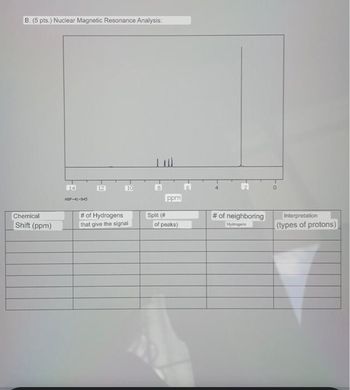B. (5 pts.) Nuclear Magnetic Resonance Analysis: Chemical Shift (ppm) 14 12 10 # of Hydrogens that give the signal 8 Split (# ppm of peaks) # of neighboring Hydrogens Interpretation (types of protons)
B. (5 pts.) Nuclear Magnetic Resonance Analysis: Chemical Shift (ppm) 14 12 10 # of Hydrogens that give the signal 8 Split (# ppm of peaks) # of neighboring Hydrogens Interpretation (types of protons)
Oh no! Our experts couldn't answer your question.
Don't worry! We won't leave you hanging. Plus, we're giving you back one question for the inconvenience.
Submit your question and receive a step-by-step explanation from our experts in as fast as 30 minutes.
You have no more questions left.
Message from our expert:
Hi and thanks for your question! Unfortunately it looks incomplete. Please resubmit the question with clear image.
We've cr2ledited a question back to your account. Apologies for the inconvenience.
Your Question:
1

Transcribed Image Text:B. (5 pts.) Nuclear Magnetic Resonance Analysis:
Chemical
Shift (ppm)
14
12
10
# of Hydrogens
that give the signal
8
Split (#
ppm
of peaks)
# of neighboring
Hydrogens
Interpretation
(types of protons)
Knowledge Booster
Learn more about
Need a deep-dive on the concept behind this application? Look no further. Learn more about this topic, chemistry and related others by exploring similar questions and additional content below.Recommended textbooks for you

Organic Chemistry: A Guided Inquiry
Chemistry
ISBN:
9780618974122
Author:
Andrei Straumanis
Publisher:
Cengage Learning

Organic Chemistry
Chemistry
ISBN:
9781305580350
Author:
William H. Brown, Brent L. Iverson, Eric Anslyn, Christopher S. Foote
Publisher:
Cengage Learning

Organic Chemistry: A Guided Inquiry
Chemistry
ISBN:
9780618974122
Author:
Andrei Straumanis
Publisher:
Cengage Learning

Organic Chemistry
Chemistry
ISBN:
9781305580350
Author:
William H. Brown, Brent L. Iverson, Eric Anslyn, Christopher S. Foote
Publisher:
Cengage Learning
